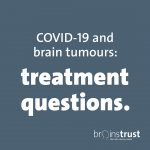“Tessa Jowell Brain Cancer Mission reveals its exciting plan to award outstanding neuro-oncology centres ‘Tessa Jowell Centre’ status within weeks – recognising centres who offer excellence in brain tumour treatment and aligned research with a strong focus on quality of life care”.
Today, two years on from Dame Tessa Jowell’s passing, Tessa’s legacy remains strong as the Tessa Jowell Brain Cancer Mission (TJBCM) announces its plans to found a national network of Tessa Jowell Centres of Excellence for brain tumour treatment and care in adults. This initiative is driven by, and for, the community of people living with a brain tumour, health professionals and scientists who have worked together to define, identify and promote excellence.
During the final year of her life, Tessa was diagnosed with a glioblastoma, one of the most aggressive brain tumours in adults. Over one hundred thousand people are currently living with a brain tumour in the UK and each year 11,400 new patients are diagnosed with a primary brain tumour. Only a quarter of those diagnosed with a glioblastoma survive more than a year. Equality of access to outstanding treatment, care and research was the call to arms Tessa ignited in her final parliamentary speech in Jan 2018, just three months before she died. Tessa suggested that all patients should benefit from “the latest and greatest science” and called on us to focus on “living well with cancer, not just dying from it”. This seminal speech received the first ever standing ovation in the House of Lords.
This exceptional call to action united the brain tumour community, galvanising overwhelming support from government, clinicians, scientists, charities and people living with a brain tumour. Together, they are realising Tessa’s dream by establishing the TJBCM and bringing excellence to as many patients as possible through the Tessa Jowell Centre Network.
Tessa Jowell’s daughter Jess Mills, who has been closely involved in designing the Tessa Jowell Centre Programme, said that “The delivery of the Tessa Jowell Centres will be a huge moment in delivering my mum’s call to action through setting a new benchmark for the outstanding delivery of care for brain cancer patients. I have been touched to see everyone work together so efficiently and have been inspired by eagerness of the brain tumour community to collectively step up and raise the bar.”
How it works – Excellence in every step of the patient pathway
Pockets of excellence are established across the UK: one hospital may have state of the art brain imaging facilities; another may have excellent and tailored rehabilitation facilities. But few centres excel in each and every step of the patient journey; as a result, many patients across the UK miss out on innovative treatment.
Based on extensive research, the TJBCM has identified and defined high standards for every step of the patient pathway, ranging from clinical care and patient quality of life through to access to innovative clinical trials. Following the launch of the programme, UK hospitals will be able to apply to take part in the rigorous assessment process to become a Tessa Jowell Centre. Hospitals that meet the standards will be awarded ‘Tessa Jowell Centre’ status. For hospitals, this award will mean that their staff will be congratulated and recognised for going ‘above and beyond’ for their patients.
For people living with a brain tumour, the award will provide reassurance that they will receive the best possible brain tumour care in those centres – for their entire pathway. The increased transparency as a result of the awards will help people to decide where to go for their treatment. Importantly, Tessa’s call was very much about bringing equality to ‘all patients’: We envisage that more and more hospitals will step up to raise the standards of the treatment they offer. As a result, a growing number of patients will be able to benefit from excellence in every step of the patient pathway.
Professor Richard Gilbertson, the Chair of the TJBCM said “this grassroots initiative has gained huge momentum over the last few months. I am delighted by the enormous interest shown already by NHS Trusts across the country who are stepping up to join us in responding to Dame Tessa’s call to action. We are currently piloting the process in a small series of Centres and we anticipate that over the next months, more and more Trusts will follow. We believe that this initiative will be a major step forward in transforming the care of patients with these underserved cancers”.
The initiative has benefitted from the leadership of a very experienced Chair, Kate Bushby (Emeritus Professor of Neuromuscular Genetics at Newcastle University). As former Vice Chair of the European Union Committee of Experts on Rare Diseases, she has extensive national and international experience in setting up centres of excellence in rare diseases. Recently, her husband sadly died from the same tumour as Tessa, and she has come out of retirement to apply her experience in overseeing the process of bringing excellence to brain tumour patients. Reflecting on the process, Katie said “It is well known that concentration of expertise and sharing of best practice leads to better outcomes for patients. When defining and setting the standards we were always thinking ‘is this good enough so that I would confidently send my own family member there for treatment?’ If the answer to the question was yes, then we included this in our standard”.
Collaborating with the NHS and charities
The team has worked in close collaboration on the initiative with the NHS. Professor Peter Johnson, The National Clinical Director for Cancer at NHS England said: “Brain tumours are among the most challenging to treat cancers. Partnership between the NHS and the Tessa Jowell Brain Cancer Mission to found the Tessa Jowell Centres, represents an enormous step forward in ensuring equality and excellence in care for patients across the UK, wherever they live.”
Helen Bulbeck, Director of policy and services at brainstrust – the brain cancer people said: “Before we are patients, we are people. We are so privileged to be part of this initiative. It means that people will be able to have the wraparound care they need and to which they are entitled, so that they can have their best possible day, no matter where they are on the brain tumour pathway.”
Catherine Fraher, Director of Services at The Brain Tumour Charity, said: “Our community wants everyone affected by this shocking and life-changing disease to have an exceptional standard of treatment and support, no matter where they live in the country, no matter what type of tumour they have. Equal access to treatment and care has been a central strand of our strategy to double survival and halve the harm caused by brain tumours. Driving excellence through the Tessa Jowell Centres status will help deliver that sooner. The Brain Tumour Charity’s community stand together with the Tessa Jowell Brain Cancer Mission to back this initiative that will drive change for everyone affected.
TJBCM is supported by the Department of Health and Social Care and brings together leading clinicians and academics, Cancer Research UK, The Brain Tumour Charity, Brain Tumour Research and brainstrust, amongst others.





